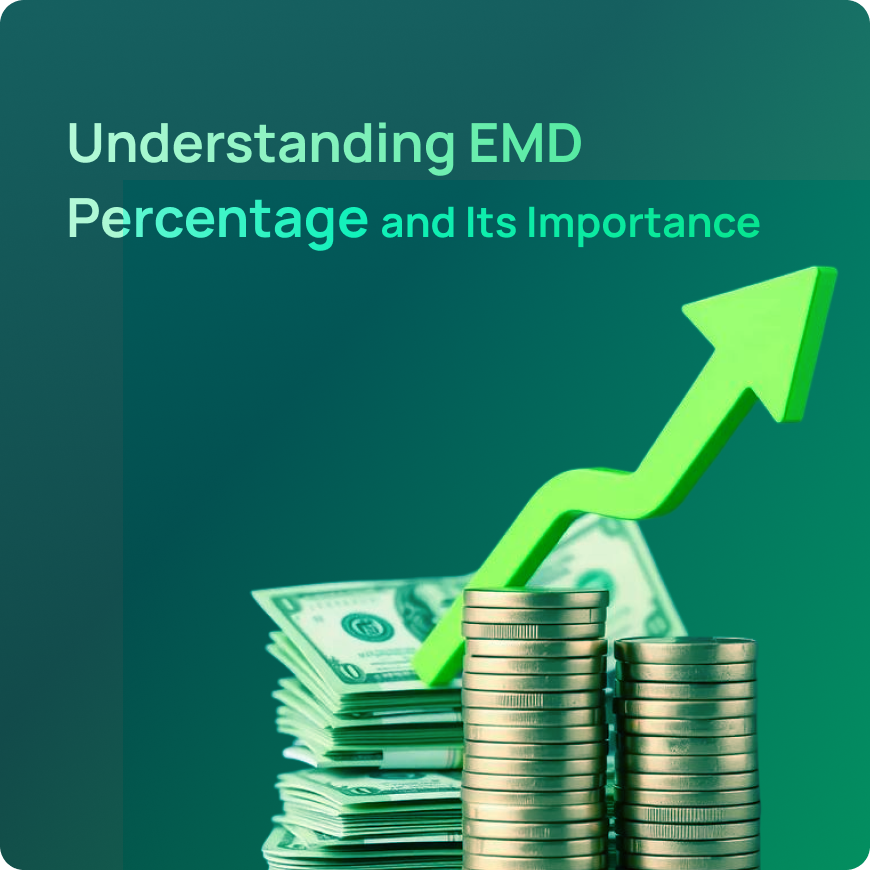What is EMD Percentage? How Is It Determined?
Understanding Earnest Money Deposit (EMD) is critical for winning government contracts. Learn the what, why, and how of EMD in Indian Railway tenders.

What is EMD Percentage? How Is It Determined?
What is the EMD percentage in railway tenders? Generally, Indian Railways tenders fix EMD at around 2% to 5% of the estimated contract value. However, the exact percentage or amount is not one-size-fits-all - it varies based on the tender’s value, nature of work, and governing procurement guidelines. Each tender document (accessible via platforms like the Indian Railways E-Procurement System (IREPS) or the Central Public Procurement Portal (CPPP)) clearly specifies the required EMD in its “Tender Conditions” or “Instructions to Bidders” section.
In Indian Railways’ works tenders, there are standard formulas for calculating EMD. For example, one railway tender document specifies: “The Earnest Money shall be @ 2% of the estimated tender value costing up to ₹1 Crore, and for works exceeding ₹1 Crore, EMD shall be ₹2 lakh plus 0.5% of the excess cost over ₹1 Crore, subject to a cap of ₹1 Crore.”. In practical terms, this means a small ₹50 lakh contract might have an EMD of around ₹1 lakh, whereas a very large project (say ₹100 Crore) could be capped at an EMD of ₹1 Crore. By scaling EMD with project size (and capping it), Railways ensure the amount is substantial enough to enforce sincerity, yet not prohibitive for big projects.
Different tender types can have different EMD norms: For instance:
Large Works Contracts: Major infrastructure works (track laying, bridge construction, station redevelopment, etc.) often see EMD in the range of ~2%-3% of the estimated cost. This could be a considerable sum given high project values, but it underscores the importance of commitment in such big contracts.
Supply and Service Contracts: Tenders for the supply of equipment, materials, or certain services may require an EMD on the higher side, sometimes up to 5% of the bid value. The higher percentage for supplies may reflect the ease of entry of traders and thus a need to ensure bids are earnest.
Small Value Tenders: For low-value procurements (often below a threshold like ₹5-10 lakh), the EMD requirement might be very low or even waived entirely to encourage participation from small vendors. In many cases, Micro, Small & Medium Enterprises (MSMEs) are exempted from paying EMD upon submitting valid certification, a policy aimed at promoting inclusive participation. Always verify the tender’s EMD clause - some notices explicitly mention “EMD Nil for eligible MSMEs” or a token amount.
Real example - EMD in a Railway tender: Let’s say Railway XYZ issues a tender to electrify a rail section, estimated at ₹5 crore. If we apply standard rules, the EMD could be around 2% (assuming it falls under the works category): that’s ₹10 lakh. The tender document will state: “Earnest Money Deposit: ₹10,00,000 to be submitted by bidder via online payment or bank guarantee,” along with details. Bidders must furnish this ₹10 lakh EMD to validate their bid. If the project were much larger (e.g., ₹50 crore), using the formula, the first ₹1 crore would require 2% (₹2 lakh), plus 0.5% of ₹49 crore (~₹24.5 lakh), totaling an EMD of about ₹26.5 lakh. However, since Indian Railways caps EMD at ₹1 crore maximum, extremely large tenders won’t demand more than that cap. This scaling prevents EMD from becoming overly burdensome as tender size grows.
Key takeaway: The EMD percentage for railway tenders usually falls in a small single-digit percentage of the project value. Always check the specific tender document, as the exact amount and percentage are mentioned for that tender (often under the “Earnest Money” or “Bid Security” clause). It’s a straightforward number once you locate it, and knowing it upfront allows contractors to prepare the required funds or bank guarantees before bidding.
Financial and Procedural Implications of EMD for Businesses
EMD requirements carry significant financial and procedural implications for contractors and bidding organizations, especially for CFOs, tendering heads, and business owners evaluating Indian Railways and other government tenders:
Cash Flow and Working Capital: When you participate in multiple Indian tenders simultaneously, EMDs can tie up a substantial amount of money. For example, bidding for five different railway projects of medium size might require upfront EMDs totaling perhaps ₹50 lakh or more, locked in until those tenders are decided. This has direct cash flow implications - money paid as EMD is money not available for other business needs until it’s refunded. From a CFO’s perspective, it’s important to budget for EMDs as part of tendering costs and ensure adequate liquidity or credit lines (e.g., for bank guarantees) are available.
Cost of Capital: While EMD is refundable, there is an opportunity cost to the funds. If a company uses its cash for EMD, it forgoes interest or alternative uses for that cash during the bid period. If a bank guarantee (BG) is used (a common practice for high EMDs), banks typically charge a commission or require margin money. These costs effectively increase the cost of bidding. Large firms factor this into their tender pricing strategy, and SMEs must be mindful of the financial strain excessive EMDs might cause.
Procedural Compliance: Procedurally, meeting the EMD requirement is often a gateway condition in public tenders. Failure to submit the correct EMD in the correct format leads to outright bid rejection. This means businesses need robust internal checks when preparing bids: the finance team must ensure the EMD amount is exactly as stipulated and use an approved payment method (e.g., NEFT/RTGS, online payment on IREPS, demand draft or BG from a scheduled bank, etc., as specified). Even a minor lapse, such as an EMD short by a few hundred rupees or a BG validity not meeting requirements, can lead to disqualification of an otherwise competitive bid. Tendering heads must double-check that EMD payment receipts or BG documents are submitted in the manner asked (often uploaded online for e-tenders, or physically delivered if demanded).
EMD Refund Timing: While unsuccessful bidders do get their EMD money back, the timing can affect their finances. Indian Railway and other government tenders usually process EMD refunds within a few weeks of contract award (often within 30 days after final bid validity or award). However, any delay in refund (not unheard of in bureaucracy) means funds stay stuck longer. In fact, the IRCTC (Railways) vigilance once highlighted cases of “inordinate delay” in refunding EMDs to losing bidders, urging authorities to streamline the process. CFOs should monitor that EMD refunds are received and follow up if they aren’t, as prolonged hold-up of funds can impact working capital. The good news is that most modern e-procurement systems, like IREPS and CPPP, have automated refund processes to credit back EMDs promptly once the tender is finalized.
Performance Security Linkage: For the winning bidder, the EMD typically transitions into something else. In many Railway tenders, the EMD of the successful bidder is not returned immediately; instead, it is adjusted toward the Performance Security Deposit or Security Deposit for the contract. For example, if a contractor wins a railway tender, their EMD might be held and later counted toward the 5% security deposit required for contract performance. The business implication is that those funds remain with the client (railways) until some portion of the work is done or until a performance Bank Guarantee replaces it. Companies should be prepared that winning a tender doesn’t free up the EMD amount instantly - it simply changes form into a longer-term security (refundable upon successful completion of the project, often many months or years later).
No Interest on EMD: It’s worth noting that no interest is paid on EMD amounts by the tendering authority. The money held by the Railways or any department is essentially an interest-free deposit. This is a minor detail, but it reinforces that bidders bear the cost of capital for the sake of participating in public procurement.
In summary, EMDs are a cost of doing business in tenders - they affect cash flow and require careful procedural handling. Companies should treat EMD requirements with the same attention as technical and financial bid components, planning financially and logistically to meet these requirements in each tender.
“Risky EMD Clauses” to Watch Out For
Not all EMD conditions are straightforward; some tender clauses related to EMD can pose hidden risks or challenges to bidders. Here are a few “risky EMD clauses” and scenarios to be mindful of in Railway tenders (and public tenders in general):
Forfeiture Triggers: Perhaps the biggest risk is forfeiture of the EMD. Tender documents spell out situations where the EMD can be forfeited (seized by the authority). Common triggers include: if a bidder withdraws or amends their bid during the bid validity period, or if the winning bidder fails to sign the contract/submit the required Performance Guarantee within the stipulated time. For example, Indian Railways’ standard clause states that if the tenderer rescinds from their offer or modifies terms unacceptably after submission, “the EMD amount shall be liable to be forfeited to the Railway.” In practice, if you put in a bid and later try to back out or change the price (perhaps because you discovered an error or won another project), you stand to lose the entire EMD. This is a significant financial risk - for large tenders, it could mean losing tens of lakhs or more. Tip: Always double-check your bid calculations and be confident in your commitment before bidding; backing out is not a viable option without penalty.
Blacklisting/Debarment Clauses: Some EMD clauses go further than just forfeiture. Bidders can face blacklisting (temporary ban from future tenders) in addition to EMD forfeiture if they default. For instance, in one railway tender case, a contractor who failed to honor an awarded bid had their EMD forfeited and was debarred from participating in any future tenders for a period. Certain tender documents explicitly mention that if EMD is forfeited for a bidder’s misconduct, the authority may ban that firm from bidding for a specified duration. This is a severe consequence: beyond losing money, it can disrupt your business pipeline. Risk management: Treat every bid as a firm commitment - if you win, you must perform or face not just financial but reputational and operational penalties.
Conditional EMD Exemptions: Many tenders offer EMD waivers for MSMEs or other categories, but these come with fine print. A “risky clause” here is failing to meet the exact conditions for exemption. For example, a railway tender may state MSME bidders are exempt only if they are registered for the item/service in question and upload a valid Udyam or NSIC certificate at the time of bidding. If a bidder assumes they’re exempt but forgets the documentation, their bid will be rejected for non-payment of EMD. Moreover, some Railway tender documents might restrict EMD exemptions for certain specialized procurements or re-tenders (e.g., if prior bidders misused the exemption, the re-tender may insist on EMD from everyone). Always read the EMD exemption clause carefully - it usually lists who is exempt and the proof required. Any oversight can render your bid non-compliant.
Validity Period of EMD/Bid Security: When EMD is submitted as a Bank Guarantee, there’s typically a required validity (often 45-60 days beyond the bid validity end date). A risky scenario is failing to have the BG valid for the required duration - if the BG expires too soon, the bid can be disqualified, or the bidder asked to extend it at short notice. Additionally, if a bidder does not extend their bid validity upon request, the EMD can be forfeited in some cases (as refusal to extend validity is akin to withdrawal). The takeaway: ensure any BG or instrument you use for EMD complies with all format and validity requirements specified.
No Second Chance on EMD Submission: Tender rules usually stipulate that no relaxation or second opportunity is given for EMD submission after bid opening. A common clause is “Tenders without the prescribed EMD shall be summarily rejected”. Unlike some minor document clarifications that authorities might allow post-deadline, EMD is a hard barrier. This is risky for bidders who might miscalculate the amount or face a last-minute payment glitch. The onus is on the bidder to ensure the EMD payment goes through successfully before the tender closing time (if paying online) or that the demand draft/BG is delivered in the correct manner by the deadline. It’s prudent to initiate EMD payments well in advance of the cut-off date to avoid technical snags that could derail your bid.
Interest-Free Deposit: While not exactly a “clause” that is risky, it’s a condition to remember - the EMD remains interest-free with the tendering authority. This means that if a tender evaluation drags on for many months (perhaps due to extended validity or retendering), your money sits idle without accrual. The risk here is indirect: long tender processes can erode the value of your deposit (in terms of opportunity cost or inflation). Bidders should be mentally and financially prepared for EMD to be in a “lock box” until the process concludes.
In summary, read the EMD-related clauses of every railway tender very closely. They outline the circumstances of forfeiture, exemption criteria, submission process, and post-bid conditions. Being aware of these details will help you avoid pitfalls such as losing your deposit or facing bans. If something is unclear (say, the wording of a forfeiture clause or exemption rule), don’t hesitate to seek clarification from the tender authority during pre-bid meetings or via the query process. It’s far better to be sure than to assume wrongly and suffer consequences later.
Case Studies: EMD in Indian Railway Tenders
To illustrate how EMD can play a critical role in bidding, let’s look at a couple of real-life scenarios drawn from Indian Railway tenders:
Case Study 1 - Forfeiture and Debarment:
A Cautionary Tale. In 2017, a contractor emerged as the lowest bidder (L1) for a Railway works tender in the Eastern Railway zone. The project was substantial, and the bidder had submitted an EMD of around ₹20 lakh. However, after being issued the Letter of Acceptance (LOA), the contractor failed to proceed with signing the contract and furnishing the performance guarantee (perhaps due to internal issues or realization of thin margins). The Railway, after giving due opportunity, invoked the tender’s EMD clause. The result: the entire EMD of ₹20 lakh was forfeited, and the contractor was debarred from participating in future railway tenders for a period (in this case, 5 years in that zone). The contract had to be re-tendered, causing delays in the project. This case underscored two things: (a) the Railways are willing to enforce strict penalties to keep the tender process earnest, and (b) bidders must be extremely careful in bidding only if they are fully committed and capable of executing the work. The financial hit of losing the EMD was significant for the company, but arguably, the loss of business opportunities due to the 5-year ban was even more damaging. As a tendering head or CXO, such an example drives home the importance of thorough bid evaluation (technical, financial, and capacity) before committing, to avoid overextending and facing punitive action.
Case Study 2 - MSME EMD Exemption in Action:
Leveling the playing field. A small MSME engineering firm eyeing a Railway procurement tender for electrical equipment found the EMD requirement to be ₹5 lakhs - a hefty amount for a small business to lock in. However, the tender fell under a category where EMD exemption for MSMEs was allowed, as per the Government of India procurement policy. The firm had a valid Udyam (MSME) registration in the relevant category. By leveraging this, they claimed the EMD exemption - instead of paying ₹5 lakh, they submitted the required documents (MSME certificate, etc.) along with a Bid Security Declaration as specified. This allowed them to participate without the upfront cost. Several larger competitors did submit the ₹5 lakh EMD, tying up their funds. The MSME firm went on to win the tender, being the lowest bidder with a technically sound offer. This outcome showcased how EMD exemptions can encourage small players: the firm might not have been able to afford the risk of ₹5 lakh floating for several months, but with the exemption, they competed on an equal footing and secured a valuable contract. Do note, had their documents not been in order, the exemption would not apply - so it wasn’t an advantage by default, but one earned by meeting the criteria. For CFOs and business heads in small companies, this case highlights the need to obtain and maintain valid MSME certifications and always check tender documents for EMD waiver provisions. It can significantly reduce the financial barrier to entry in government tenders.
(These case studies are based on typical scenarios and reported instances in railway tendering. They emphasize the financial stakes associated with EMD and the importance of adhering to tender rules. Always refer to official tender outcomes and documentation for precise details in any specific case.)
How AI Tender Analysis Can Help Mitigate EMD-Related Risks
In the era of digital procurement, the sheer volume and complexity of tender documents can be overwhelming. This is where AI (Artificial Intelligence) Tender Analysis tools are becoming game-changers for businesses. Advanced software leveraging AI and machine learning can scan and interpret tender documents - including all clauses on EMD - to assist contractors and procurement teams in making informed decisions. Here’s how AI-driven tender analysis can help specifically with EMD-related aspects:
Quick Identification of EMD Requirements: Instead of manually hunting through a lengthy railway tender document for the EMD clause, an AI-based tool can instantly highlight the EMD amount, form, and deadline. For example, as soon as a new Railway tender is published on IREPS or CPPP, an AI tool can parse the PDF and alert your team: “EMD of ₹X (2% of estimate) required, payable via online portal by date Y. MSME exemption applicable with certificate.” This ensures you never miss the critical EMD detail that could make or break your bid’s acceptance.
Analyzing “Risky Clauses” Automatically: Remember the “risky EMD clauses” we discussed? AI can be trained to flag those for you. If a tender has an unusual condition, say “No EMD exemption for any bidder” (which sometimes is the case in sensitive procurements) or “EMD valid for 1 year” - the system can mark it out. It can also detect clauses about forfeiture and blacklisting, ensuring decision-makers are aware of the stakes. By surfacing these points, AI tools help mitigate risk: your bid/no-bid decisions and bid strategies will factor in all EMD-related obligations. This is especially useful for busy CXOs who may not read every page of the tender - the AI does the heavy lifting and summarizes the key risks.
Natural Language Processing (NLP) for Clause Interpretation: Modern AI tools use NLP to interpret the legalese in tender docs. They can convert a dense paragraph about bid security into plain-language bullet points for you. For example, an NLP engine might read a clause and output: “EMD 5% of project cost, must be in the form of DD/BG; valid 90 days; forfeiture if withdrawn before 120 days; MSMEs with NSIC cert exempt.” This ensures you fully understand the EMD obligations and options without having to decipher jargon, thus empowering even those who are not tender experts to grasp the requirements quickly.
Incorporating AI tender analysis into your workflow can significantly reduce the risk of EMD-related mistakes (like missing a payment or misunderstanding a clause) and improve efficiency. It’s like having a vigilant team member who reads every tender from top to bottom, extracts the key points on EMD, and warns you of any red flags. For organizations aiming to scale up participation in Indian tenders (including railway tenders) without scaling up their procurement teams linearly, such tools are invaluable.
Conclusion: Embracing technology doesn’t replace due diligence, but it amplifies it - AI ensures that crucial requirements like EMD are never overlooked and are always clearly understood, thereby safeguarding your bid from technical rejections and financial pitfalls.



